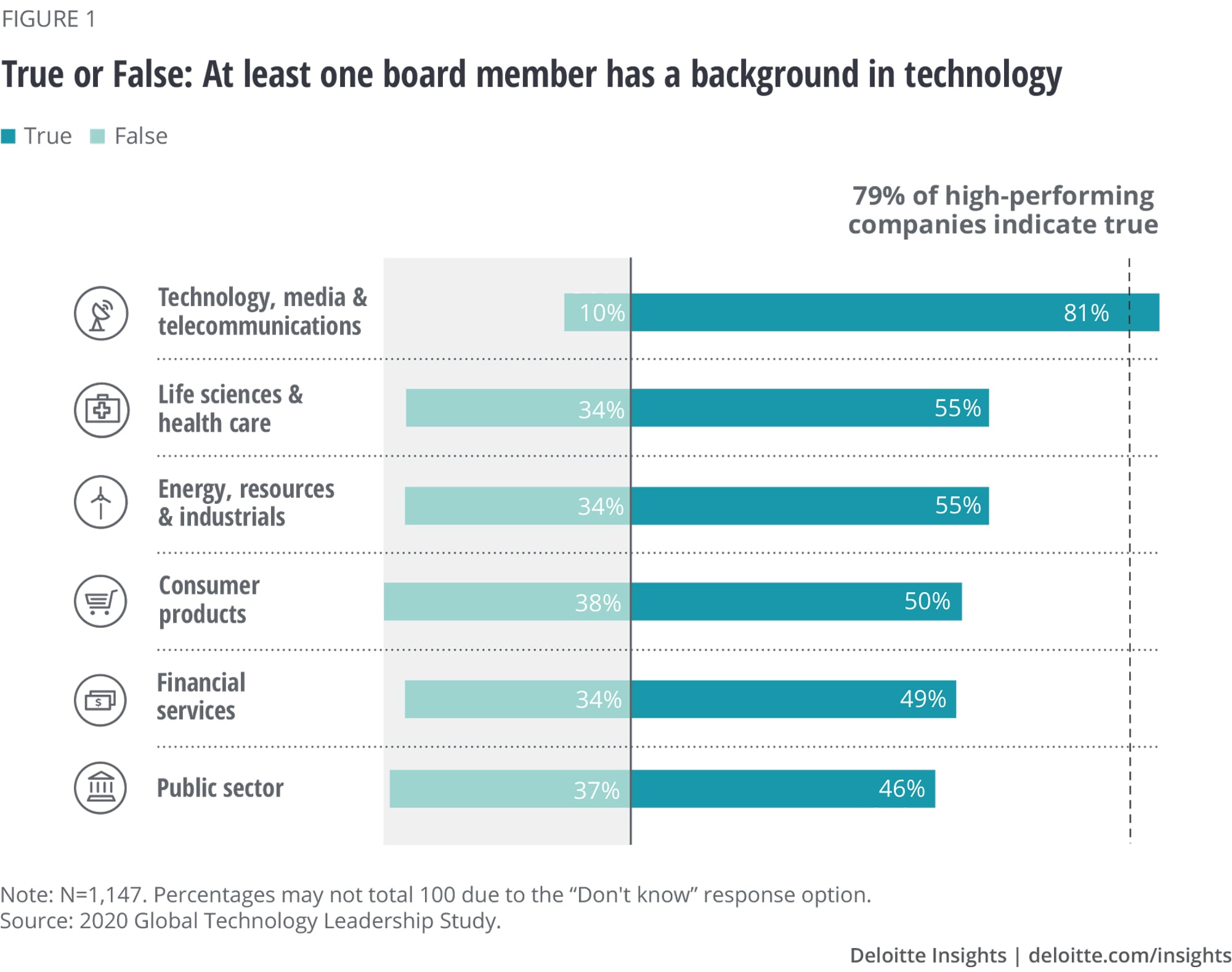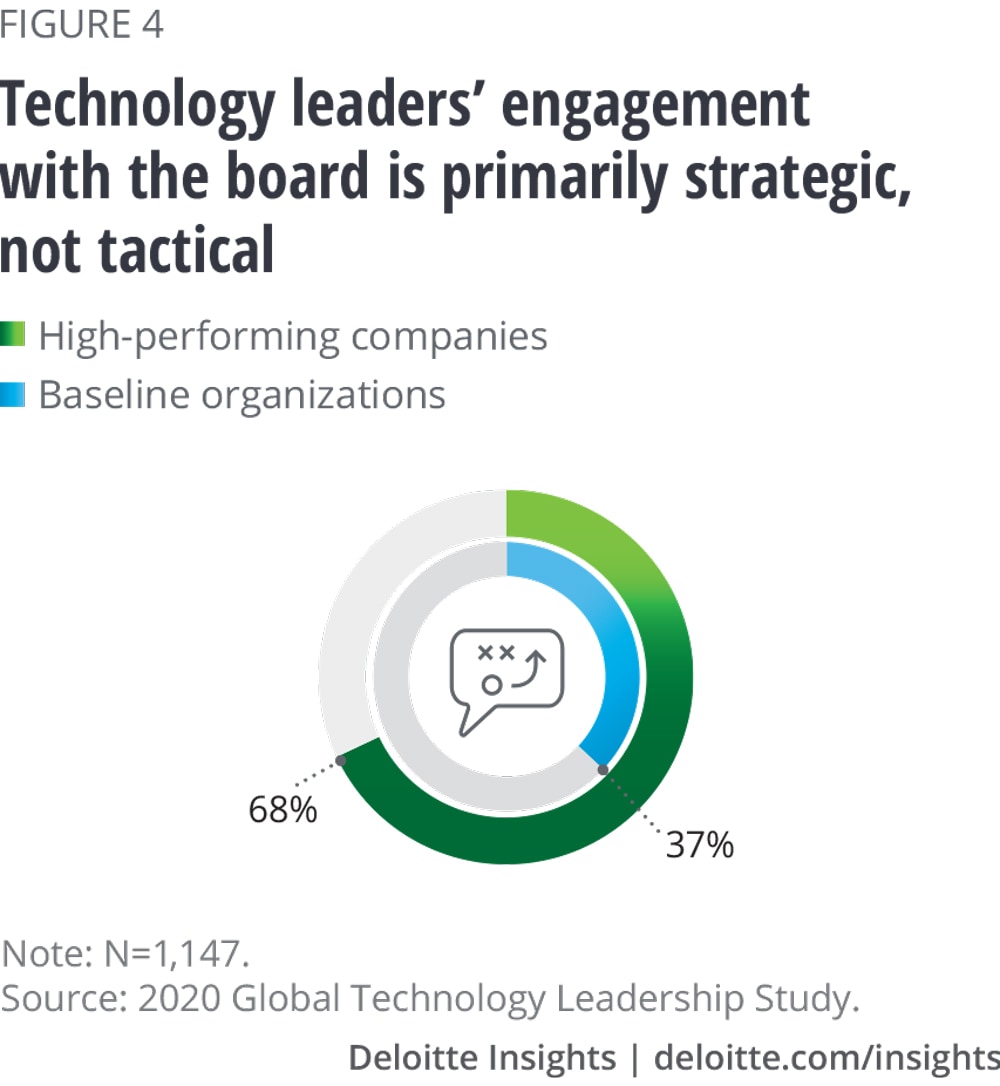
Forging alliances: How tech leaders and boards collaborate to deliver agility, resilience, and performance CIO Insider
7 minute read
24 July 2020
A defining trait of high-performing organizations is the strong relationships between their technology leaders and boards—an alliance that can become even more crucial during a crisis. What steps can CIOs take to build and foster these strong alliances?
Some organizations have quickly and effectively responded to the 2020 global pandemic, while others are struggling. What traits contributed to the high performers’ agility and resilience? And what can technology leaders do now to help their organizations prepare for future disruptions?
Learn more
Explore the CIO Insider collection
Learn about Deloitte’s services
Go straight to smart. Get the Deloitte Insights app
Our 2020 Global Technology Leadership Study identified several factors that distinguish high-performing organizations, but one stood out: The corporate directors of these organizations have a strong positive relationship with technology and the CIO. Their leaders and board members advocate for, prioritize, and appreciate the value of technology. These organizations are often better positioned to respond to crises, jump-start their recovery, and develop new business opportunities that make it possible to thrive in the future.
While tech leaders are likely to engage in strategic business conversations with CEOs and business leaders in their day-to-day work, frequent interactions with board directors are typically not a natural, everyday occurrence. Building a strong alliance with boards to support tech-enabled strategies is an intentional act driven by tech leaders that requires purposeful planning and effort.1
Technology is a strategic lever for high-performing companies
Tech leaders and boards of high-performing organizations share a bold, tech-enabled vision of the future that guides their priorities, decisions, and investments. These boards actively champion transformative change and are more highly engaged in strategic decisions around how to use technology to drive organizational performance and growth. They advocate for, prioritize, and appreciate the value of technology—traits that could improve organizational agility and resilience, enabling the organization to prosper in both stable and uncertain environments.
High-performing companies use technology to drive transformation, not simply incremental change. Compared to baseline organizations, high performers are four times more likely to use technology to drive corporate strategy than other organizations. One board director said it well: “Technology is the essence of our strategy; it is the essence of everything that we're doing.”2
What is a high-performing organization?
According to Deloitte’s 2020 Global Technology Leadership Study, high-performing organizations (referred to as technology vanguards in the report) are more advanced than their peers in vision and strategy, technology function maturity, and market leadership. The study showed that high performers made up 11.6% of the participating organizations; the remainder (88.4%) were identified as baseline organizations.
Compared to baseline organizations, high performers are more likely to emphasize innovation, customers, and growth. They look to innovation to capture new revenues and expand to new markets. They’re customer-first, leveraging technology to improve customer experiences and even engaging customers in the innovation process. This growth orientation will likely encourage them to continue to invest in the future even as they respond and recover from a crisis environment.
High-performing companies also are more likely to have directors with a technology background. Our survey data suggests that 79% of high performers have at least one board member with tech experience, compared to only 52% of baseline organizations. Across industries, only about half of the surveyed organizations have a director with tech experience, except for the technology industry, where, unsurprisingly, the number is significantly higher (figure 1). As technology is a key driver for corporate strategy across industries, organizations should consider increasing the tech-savviness of all directors, regardless of whether they have a work or educational background in technology.

Surveys and interviews show that directors and CEOs are counting on their tech leaders to lead transformational change—which implies that having tech leaders who are visionary and persistent is the need of the hour. Bill Freda, board member, State Street Corporation, Guardian Life Insurance Company, and Hamilton Insurance Group, says, “Innovators—and the ability to execute—are going to be the key to success for future tech leaders.”3
Three essential elements of alliances between tech leaders and boards
Foundation of trust to pursue a bold vision
Boards and leaders of high-performing companies share a bold vision around how technology investments can help them meet the strategic goals that they aggressively pursue (figure 2).

But not every CIO can go to the board and expect directors to buy into these investments. To convince the board to pursue a technology-enabled vision, the tech leader should have a track record of delivering successful projects and consistently providing system reliability and security. Without the credibility of past performance or experience delivering transformative change, CIOs may find it difficult to convince the board to risk making substantial technology investments.
“Tech leaders need tenacity, which means making a decision, standing by it, and staying the course.”—Gaurdie Banister, former CEO of Aera Energy, board member of Tyson Foods and Russell Reynolds Associates, former board member of Bristow Group and Marathon Oil.4
Ongoing opportunities for informal and ongoing engagement
Nearly three-quarters of tech leaders of high-performing companies have frequent, informal touch points with their boards of directors, compared to only 44% of baseline organizations (figure 3). These recurrent interactions can allow for iterative conversations, not just status checks, which can deepen relationships and understanding. Beyond sharing ideas about how technology can help the organization reach its goals, tech leaders gain insights into directors’ interests and concerns, as well as their interpersonal dynamics. This could also serve as an opportunity to educate and engage the directors on technology topics and increase the technology acumen of the board.
With more boards moving to virtual meetings, consider reviewing the governance rules to increase meeting frequency. This can help management be more nimble since corporate and tech leaders can get insights into the board’s mindset without waiting for a quarterly meeting. These ongoing conversations can also help the management team stay in sync with the board, which is one of the defining characteristics of high-performing organizations (81%, versus 56% for baseline organizations).

Balanced oversight across resilience issues and growth opportunities

Most high-performing companies (68%) report that boards and tech leaders engage on strategic issues, compared to 37% of baseline organizations (figure 4). Our interviews with high-performing boards reveal that they not only have more strategic conversations with their tech leaders, they are also much more likely to balance their offensive and defensive conversations. Of course, a crisis warrants leaders and boards to focus on defensive responses and capital preservation; however, it’s important not to lose sight of potential long-term opportunities.
Tech leaders may introduce ideas for continuing to pursue growth—even during difficult economic times—while still addressing immediate operational resiliency and other concerns. For example, if funding is not available for major tech initiatives that carry higher risk, some savvy tech leaders propose creative funding and financing options—such as vendor subsidies, ecosystem investments, university partnerships, and carveout leasebacks.
Key recommendations: Essential questions for boards and technology leaders
As technology becomes a key lever for corporate performance, collaboration between the tech leaders and boards will be essential for shaping and delivering on corporate strategies. Periodic touch points on capital allocation, risk, and audit issues, although essential, will not be sufficient. Boards will need to find ways to be savvier on technology topics, and tech leaders will need to be more creative in articulating the impact and value of technology across the organization. All this will require a deeper appreciation and continued intentional effort by boards and tech leaders. As these engagements take place, the following questions can be used to deepen this dialogue:
- What are the governance guidelines for technology investments?
Many high-performing organizations have flexible investment and governance guidelines. Unfortunately, our 2018 global CIO survey suggests that 14% of organizations don’t have a consistent way to measure the return on technology investments that adjusts for commensurate risks and rewards. For example, investing in new technologies with high potential rewards and a low initial cost should require a lower minimum return on investment than a high-risk, high-cost business transformation project. Similarly, some fast-moving projects may deliver a minimal viable product that could lead to competitive advantage. In this case, the technology governance process should allow for flexibility and agility.
- What percentage of technology spend is fixed cost?
Gone are the days when the bulk of the IT budget was spent on fixed costs, such as licensing, data center, and complex multiyear projects. Many tech leaders today understand the importance of reducing fixed costs and are figuring out ways to shift technology spend quickly as market conditions change. The business disruptions resulting from the global pandemic provided a wake-up call for organizations that have not begun to shift to cloud-based models that offer scalable, flexible technology infrastructures and services that can adapt to fast-changing conditions.
- How much technical debt do we have?
Technical debt reflects the cost that would be required to fix problems with existing applications, systems, and infrastructure that resulted from taking shortcuts and quick fixes, which compound over time. Technical debt can drag down the tech function because there is little incentive or budget to invest in fixing these nagging problems. High-performing organizations actively manage and minimize technical debt to improve performance and agility.
- Will the current technology operating model and culture support future strategy?
Collaboration is difficult in a siloed organization, and innovation cannot thrive in a work environment that doesn’t tolerate mistakes. In high-performing organizations, boards and tech leaders oversee the technology function’s culture and operating model to anticipate roadblocks and potential areas of conflict that would hamper strategy execution.
- How do we compare to our competition?
Traditionally, boards have benchmarked performance against industry competitors to assess their technology function. This alone is no longer an effective measure. Boards and technology leaders should instead ask, “Will technology be a key enabler for the future of our business?” If yes, they should look beyond their industry for potential disruptors, which are increasingly turning current business models upside down.
- What technology capabilities can help reimagine the future of work and the workplace?
Savvy technology leaders are helping the business reimagine future workplaces and physical footprints by helping define new roles, digitizing and automating work, and leveraging technologies like learning platforms, virtual collaboration tools, and AI to augment human skills and increase productivity.
- What are the key obstacles in attracting and engaging top technology talent?
Top technology talent is required for organizations to maintain competitiveness. As one board member says, “To assess a technology leader, I pay special attention [to] his or her direct reports – a high-performing technology leader will attract high-performing talent.” Many savvy boards oversee tech leaders’ compensation, succession plans, and engagement to help create environments where high-performing technology talent can thrive.
It will take time, effort and tenacity to forge this alliance. But once established, it can help launch the organization into a new era of greater agility, resilience, and performance through good times and bad.
© 2021. See Terms of Use for more information.
More from the CIO Insider collection
-
Reimagining the technology operating model Article4 years ago
-
The new CIO: Business-savvy technologist Article5 years ago
-
Beyond innovation by shotgun Article5 years ago













